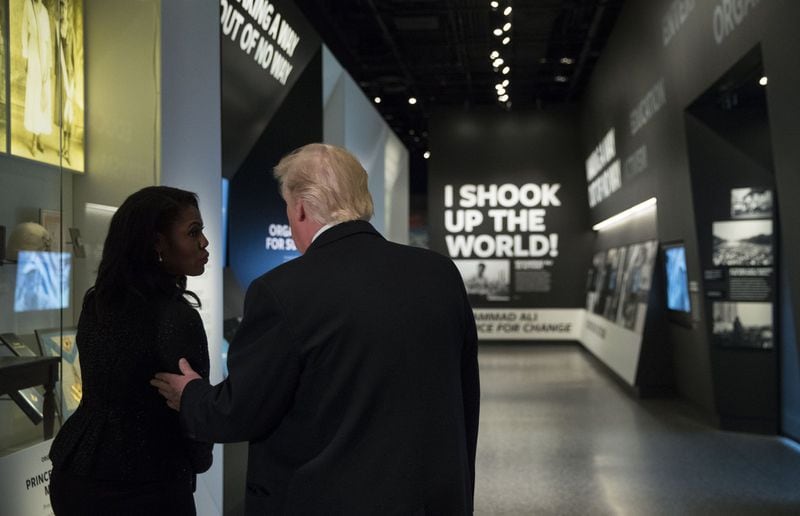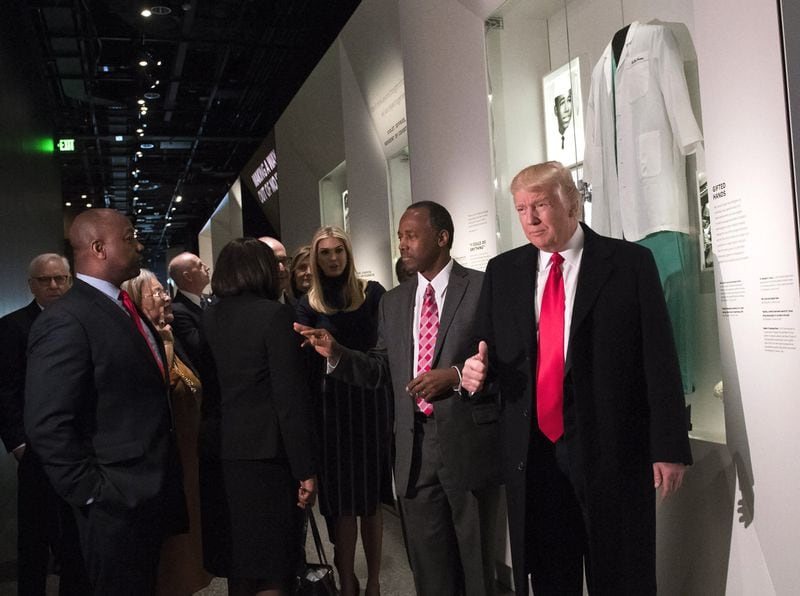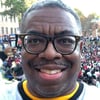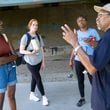Alveda King noticed two moments on Tuesday when President Donald Trump seemed visibly moved during his tour of the National Museum of African American History and Culture.
The first came when his gaze fell on a stone auction block from Hagerstown, Md., on which slaves would stand before being sold.
King, part of a small delegation to tour the new Smithsonian with the president, overheard Trump say: “Boy, that is just not good. That is not good.”
Later, they came upon a set of shackles that were used to restrain children.
“That is really bad,” King quoted the president as saying. “That is really bad.”
Trump was making his first visit to the celebrated museum that recognizes 400 years of black struggle and achievement in the United States – from slave ships to the Mothership.
Recalling Spotswood Rice, a runaway slave who joined the Union Army and wrote that he believed that blacks always looked to the United States as a promised land of universal freedom, Trump said: “Today and every day of my presidency, I pledge to do everything I can to continue that promise of freedom for African-Americans, and every American. Nothing is more important.”
“This tour was a meaningful reminder of why we have to fight bigotry, intolerance and hatred in all of its very ugly forms,” Trump said.
If Trump wants broad support among African-Americans, he has work to do, and some thought he may have begun that work with Tuesday’s visit.
Alveda King, an early supporter of Trump, said his visit sent a positive message to black Americans, only 8 percent of whom voted for Trump in November.
Others were skeptical.
Janice Mathis, executive director of the National Council of Negro Women, whose founder (Mary McLeod Bethune), and longest-serving leader (Dorothy I. Height), are featured throughout the museum, said it is now incumbent on Trump to prove that his visit can go beyond symbolism and optics toward making meaningful public policy.
“History is always instructive and the museum tells a powerful story, so it is unlikely that he wouldn’t be moved by his visit,” Mathis said. “Now, it is my hope that the visit will move beyond a celebration of Black History Month and that he will now consider public policy that is appropriate for a culturally and racially diverse nation today.”
Trump ran on a platform that seemingly filtered the black experience to a narrow scope of crime, poverty and violence. Since the election, he has continued to stumble through racial hurdles.
Unlike his predecessors, George W. Bush and Barack Obama, who had diverse cabinets, Trump has appointed only one African-American to his inner circle, HUD Secretary Ben Carson.
Last week, in a back and forth with April Ryan of American Urban Radio Networks, he asked the journalist – the only black reporter called on at a lengthy press conference — to set up a meeting with Congressional Black Caucus, saying, “Are they friends of yours?”
And while he mentioned Frederick Douglass Tuesday as one of the "many American" heroes who helped build the country, earlier this month Trump remarked that Douglass was "an example of somebody who's done an amazing job and is being recognized more and more, I notice" — giving the impression to many that he didn't know who the former slave and abolitionist was.
Alveda King, the niece of Martin Luther King Jr. and a staunch anti-abortion conservative, was called by the White House last week and asked whether she would be interested in touring the Smithsonian’s newest and most popular museum with the president.
“It was just that simple. I pray for the president and the first lady,” said King, the spiritual adviser to the National Diversity Coalition for Trump. “I like what they are doing and I needed to go to the museum. It was also my first time going.”
King went to the White House early Tuesday, where she met with Carson and Sen. Tim Scott of South Carolina — one of only three black senators and the only black Republican in the chamber.
“I believe that President Trump’s willingness to come to the museum with Secretary Carson, Sen. Scott and me, who prays a lot, was a good thing.”
King said the group started at the bottom of the museum, first visiting a gallery that focuses on the history of slavery and features remnants of a sunken slave ship.
Accompanied by Lonnie Bunch, the museum’s founding director, they also visited an exhibit featuring Thomas Jefferson, author of the Declaration of Independence. The title of the exhibit was “The Paradox of Liberty.”
The president saw exhibits dedicated to Oprah Winfrey, Muhammad Ali and Carson, who was a renowned neurosurgeon hailed in black communities.
King said she remembers seeing a photo of John Lewis but couldn't recall whether it was his full exhibit. She said she didn't hear Trump, who had a public feud with Lewis in January after the congressman said Trump "was not a legitimate president," comment on Lewis.
She said the group also saw the few instances in which Martin Luther King Jr. is featured in the museum.
Trump used the occasion to quote a 1955 speech by King about the Montgomery Bus Boycott in which King famously said: “We are determined here in Montgomery to work and fight until justice runs down like water, and righteousness like a mighty stream.”
“That is what it is going to be,” Trump said Tuesday. “We are going to bring this country together. Maybe bring some of the world together. We have a divided country. It has been divided for many, many years, but we are going to bring it together. I hope everyday of my presidency, we will…work toward a very worthy goal.”
Trump notes anti-Semitic threats
President Trump, who has been criticized for not speaking out against a rise in anti-Semitism since he was elected, used his visit to the African-American history museum on Tuesday to address it.
“The anti-Semitic threats targeting our Jewish community and community centers are horrible and are painful and a very sad reminder of the work that still must be done to root out hate and prejudice and evil,” the president said.
About the Author









